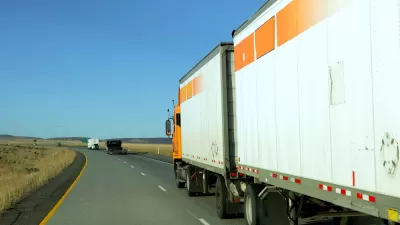Forty so-called Tier 4 locomotives, a U.S. Environmental Protection Agency designation requiring a dramatic reduction in particulate and nitrogen oxide emissions, will be joining Metrolink's fleet covering 512 track miles in six counties.
"The Metrolink commuter railroad on Monday unveiled the first of 40 clean-air locomotives that will replace its aging fleet of diesel engines in an effort to reduce harmful exhaust emissions across the region," reports Dan Weikel for the Los Angeles Times.
Officials say three will go into operation this year. The rest will be phased in by 2018.
Metrolink was the first to purchase the cleaner locomotives in 2012 so it is only fitting that they are the first to receive them. It is also appropriate that they debut in Los Angeles as the city suffered the worst ozone pollution in the United States last year.

The new locomotives, built by Illinois-based Electro-Motive Diesel, will do more for Metrolink than just produce less pollution.
"This is quite a piece of equipment,” said Art Leahy, Metrolink’s chief executive, during ceremonies at Union Station in downtown Los Angeles. “We will get more horsepower, less fuel consumption and lower emissions.”
"Tier 4 locomotives are compliant with the latest U.S. Environmental Protection Agency (EPA) emissions standards and will reduce particulate matter and nitrogen oxide [NOx] emissions by up to 85 percent," according to Metrolink. See Tier 4 fact sheet [PDF].
"According to the South Coast Air Quality Management District, each locomotive will emit up to 12 fewer tons of nitrogen oxide a year while the reduction in particulates will be about a third of a ton," adds Weikel.
Last year, the federal government required that rebuilt locomotives and new engines purchased by passenger and freight railroads must reduce nitrogen oxide emissions by 80% and particulates by 90%.
Transitioning to cleaner fleets is vital to reaching our clean air goals,” said Wayne Nastri, acting executive officer of the South Coast Air Quality Management District, which has committed $111 million to purchase the Tier 4 engines.
That would account for 40 percent of the $280 million tab for the 40 locomotives, or $7 million per locomotive.
Funds included $34.66 million from the air district's Carl Moyer Program.
Funding was also secured from:
- Federal Transit Administration,
- California Department of Transportation,
- California High Speed Rail Authority and
- Metrolink member agencies in Los Angeles, Orange, Riverside, San Bernardino and Ventura counties.
Metrolink also serves northern San Diego County.
Losing Riders
Weikel adds that the clean locomotives "are part of a broader program to improve customer service." Unlike it's much smaller, but much older, northern California counterpart, Caltrain, which has increased ridership for six consecutive years, Metrolink has lost riders since a devastating, head-on crash with a Union Pacific train in Chatsworth in September 2008 that left 25 dead. The Metrolink engineer had been found to be texting at the time.
According to Wikipedia, ridership in the last quarter of 2015 was 40,500, eighth highest in the nation after Caltrain.
Hat tip to Susan Frank, Better World Group.
FULL STORY: Metrolink unveils new locomotives that could help improve the region's air

Planetizen Federal Action Tracker
A weekly monitor of how Trump’s orders and actions are impacting planners and planning in America.

Chicago’s Ghost Rails
Just beneath the surface of the modern city lie the remnants of its expansive early 20th-century streetcar system.

San Antonio and Austin are Fusing Into one Massive Megaregion
The region spanning the two central Texas cities is growing fast, posing challenges for local infrastructure and water supplies.

Since Zion's Shuttles Went Electric “The Smog is Gone”
Visitors to Zion National Park can enjoy the canyon via the nation’s first fully electric park shuttle system.

Trump Distributing DOT Safety Funds at 1/10 Rate of Biden
Funds for Safe Streets and other transportation safety and equity programs are being held up by administrative reviews and conflicts with the Trump administration’s priorities.

German Cities Subsidize Taxis for Women Amid Wave of Violence
Free or low-cost taxi rides can help women navigate cities more safely, but critics say the programs don't address the root causes of violence against women.
Urban Design for Planners 1: Software Tools
This six-course series explores essential urban design concepts using open source software and equips planners with the tools they need to participate fully in the urban design process.
Planning for Universal Design
Learn the tools for implementing Universal Design in planning regulations.
planning NEXT
Appalachian Highlands Housing Partners
Mpact (founded as Rail~Volution)
City of Camden Redevelopment Agency
City of Astoria
City of Portland
City of Laramie



























